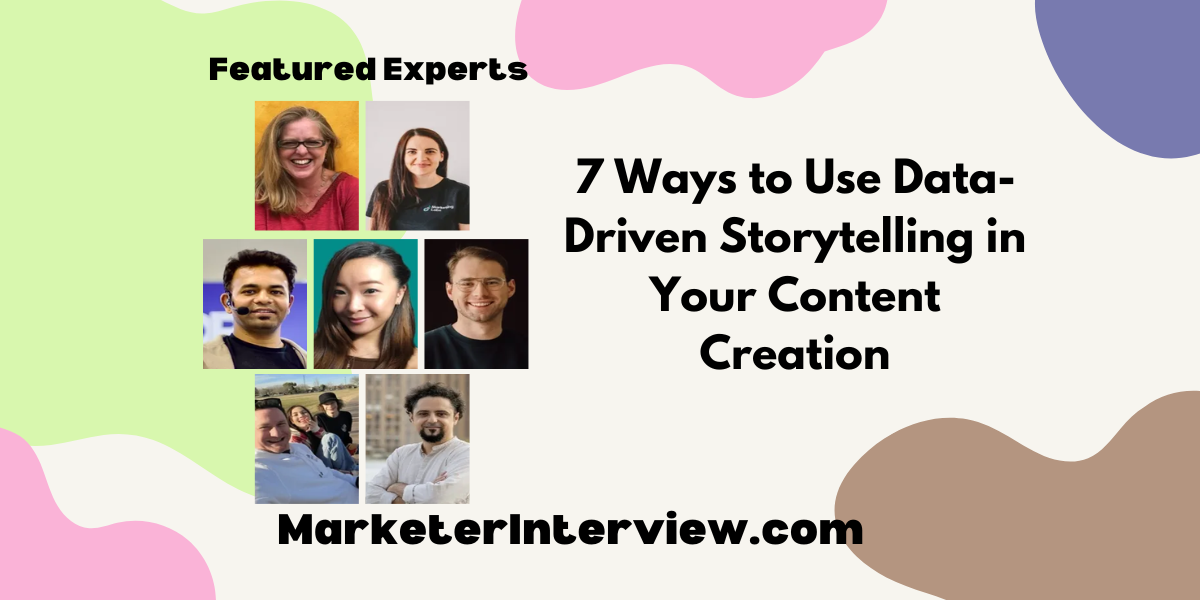7 Ways to Use Data-Driven Storytelling in Your Content Creation
In the quest to captivate audiences with compelling content, we’ve gathered seven expert insights on mastering data-driven storytelling. From copywriters to CEOs, these professionals highlight the importance of a clear narrative and the power of personalization. Discover how to use visuals effectively and align your narrative with data insights to transform your content creation strategy.
Want to get quoted in MarketerInterview.com content just like this? Apply to become a contributor today!
Contents
Use Visuals With a Clear Narrative
Everyone talks about data-driven storytelling, but not everyone understands what it means. My best tip is to use relevant data to create graphs and other visual aids so it’s easier to digest. Include a narrative with a beginning, middle, and end with these visuals so your audience has context. Graphs plus a narrative geared toward the right audience can make a compelling story your audience remembers.

Jennifer Phillips April, Copywriter and Content Strategist , Write Words Marketing
Contextualize Data With Relatable Comparisons
My top tip for using data as the hook for a story is to contextualize it. On its own, data doesn’t mean much to anyone. For it to really resonate with people, it needs context.
By presenting the data in a way that means something to your reader, you can create a meaningful and memorable connection with your audience.
Equate your statistics to something the reader will recognize. Tell them what the number equates to using a comparison with an everyday item or occurrence to really make them stop and think. If you can do this, your content is more likely to be recalled and shared.

Mel Healy, Head of Content, Marketing Labs
Highlight Impactful Data Points
One key best practice for using data-driven storytelling in content creation is to highlight the most impactful and relevant data points. The goal is to turn complex data into an engaging, easy-to-understand narrative. To do this effectively, select data points that will be most meaningful and compelling for your audience.
For example, Nectar Sleep, a direct-to-consumer mattress brand, uses the data point “More than 5.5 million happy sleepers” as a unique selling proposition on their website. This statistic immediately builds trust and suggests widespread satisfaction. Additionally, Nectar Sleep offers a wealth of data-driven content about sleep on their blog, which helps to further build trust and demonstrate their expertise in the sleep industry. By combining significant data points with informative content, Nectar Sleep creates a compelling narrative that resonates with potential customers and establishes their authority in the market.

Sid Tiwatne, Founder & Lead SEO Strategist, Tactic One
Craft Narratives From Customer Data
Leverage customer data to craft relatable and compelling narratives. By using real-life data points and success stories, you can create content that resonates deeply with your audience. This approach not only engages readers but also builds trust and credibility, making your content more impactful and memorable.

Alex Stasiak, CEO & Founder, Startup House
Focus on Data’s Real-World Impact
One effective tip for data-driven storytelling in content creation is to focus on the “so what” factor. While presenting data is important, what truly resonates with our audience is the meaning behind the numbers. Start by identifying the key insight or takeaway from your data, then craft your narrative around why this matters to your readers.
For example, instead of simply stating, “Our cloud solution reduced IT costs by 30%,” expand on how this translates to real-world benefits for businesses, such as increased budget for innovation or improved competitiveness in the market.
To implement this approach, begin your content with a compelling hook that highlights the impact of your data. Then, weave in supporting statistics and facts throughout your story, always tying them back to the central theme or benefit you’re showcasing. Use vivid examples or case studies to illustrate how the data translates to tangible outcomes. Remember, your goal is not just to inform, but to inspire action or change perspective. By focusing on the implications and relevance of your data, you’ll create more engaging and persuasive content that resonates with your target audience.

Shawn Boehme, Director of Sales, PanTerra Networks
Weave Data Into Compelling Stories
Context matters. Raw numbers and statistics, while interesting to many, are not going to be what really hooks people in your story. You need to contextualize your data with a compelling narrative, weaving it into a story that highlights the significance and impact of the data. This helps to connect with the data and have it be more than just numbers on a page.
My suggestion is to start with a human element or a real-world scenario that the data affects—I just saw a piece of content that started by showing a social engineering attempt that used the WhatsApp identity of a company president to target that company’s employees, and then moved on to the numbers of attempts that the company blocks on a regular basis as a way to set people up to buy cybersecurity solutions, for example. Bring your numbers to life with visual aids like charts, graphs, and infographics to make complex data more accessible and engaging.

Dragos Badea, CEO, Yarooms
Align Narrative With Data Insights
One specific best practice is to start by identifying a compelling narrative that aligns with your data insights. Rather than overwhelming your audience with raw data, craft a story that effectively communicates the key message or takeaway supported by the data. Begin by analyzing your data to uncover meaningful patterns, trends, or insights. From there, develop a captivating storyline that highlights the data-supported narrative, making it relatable and engaging for your target audience.
Utilize visuals, such as charts, infographics, or data visualizations, to present the data in a visually appealing and easily digestible format. Seamlessly weave the data into your content, supporting your key points and enhancing the overall storytelling experience. Incorporate real-life examples or anecdotes that illustrate the impact of the data, making it more relatable and tangible for your audience. Finally, conclude by summarizing the main insights derived from the data and reinforcing the key message of your story.

Joyce Tsang, Content Marketer and Founder, Joyce Tsang Content Marketing
Want to get quoted in MarketerInterview.com content just like this? Apply to become a contributor today!






